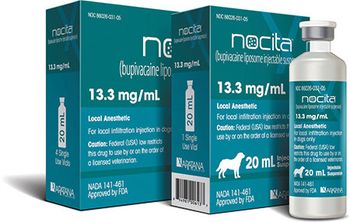Anesthesiology & Pain Management
Latest News
Latest Videos
More News

This veterinary pain and bioethics expert has an issue with conventional terminology surrounding feline declaws.

A veterinary oncologist outlines what every veterinarian should know when counseling owners on complementary and alternative medicine treatments for their cancer patients.

Pain management in feline patients is especially challenging due to difficulty in diagnosing their pain and the limited number of pain control medications available for cats. But newer hands-free tools can expand your veterinary toolbox for feline pain control.

According to internal medicine specialist Dr. Daniel Langlois, long-term maintenance of hypoadrenocorticism can be a controversial topic.

Addressing critical issues first, such as hemorrhage, shock and electrolyte abnormalities, can greatly improve the likelihood of survival after transfer to emergency care.

In a session promising feline cancer CliffsNotes, Fetch dvm360 conference speaker and veterinary oncologist Sue Ettinger shared her take on diagnosing and treating this cancerous condition.

Veterinary pain management expert Dr. Jennifer Johnson offers reasons to consider pulsed electromagnetic field therapy, especially in your painful feline patients.

The future of treating conditions like osteoarthritis has arrived, and these veterinarians say that you (yes, you) can see it through.

Results from the Golden Retriever Lifetime Study by Morris Animal Foundation focus on golden retrievers, but report posits data could apply to other large breeds.

While some in the veterinary world might be raring to throw a CBD is legal! parade, there are a few caveats keeping you from tossing confetti. Lets walk through it.

Practicing evidence-based veterinary medicine is all well and good when the evidence is clear-cut. But as articular cartilage expert Dr. Emma Adam knows, the data on use of hyaluronic acid in horses are often ambiguous.

Time is of the essence when determining whether an equine patient has this potentially life-threatening problem. So, make sure you know what diagnostic clues to look forand what could be a red herring.

A veterinary patient presents with symmetrical lupoid onychodystrophybut dont tuck your tail at a patients odd nails! Heres all you need to know about this common inflammatory disease.

Just like in people, proper rehabilitation in pets requires exercise, but you dont need to have lots of fancy equipment to make it happen. Heres what you need to know before devising a rehab program, plus some exercises that any practitioner can employ.

This veterinarian-backed scientific study out of the University of Pennsylvania will be among the first of cannabinoid therapy for pets.

Understanding the medications used to manage persistent pain will improve your ability to care for your veterinary patients. Heres a rundown of the available pharmacologic options.

Osteosarcoma is a highly aggressive and locally destructive cancer in veterinary patients. Heres the latest on diagnosis, treatment and prognosis for these common bone tumors in dogs and cats.

Heres our regular roundup of new and noteworthy veterinary products.

Veterinary surgeons: Not familiar with wound soaker catheters? Youll want to be. They are easy to place and remove and can simplify your local pain control regimen for some surgical patients.

Adding locoregional anesthetics into routine ovariohysterectomy and orchiectomy protocols is a rapid, safe and inexpensive way to enhance pain control for our veterinary patients.

Heres our regular roundup of new and noteworthy veterinary products.

The smaller vial is expected to be available later this year.

The veterinary team behind the ongoing clinical trial has found that 89% of dogs who received cannabidiol had a reduction in frequency of seizures.

Its never too late to correct oral problems, as long as the patients age remains top of mind.

If you dread these difficult client conversations, veterinary palliative care expert Dr. Katherine Goldberg has straightforward advice for how to use them as opportunities to discuss goals and ultimately achieve better outcomes for the client and the pet.







